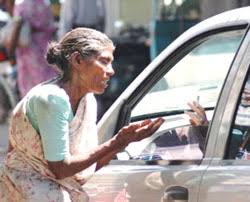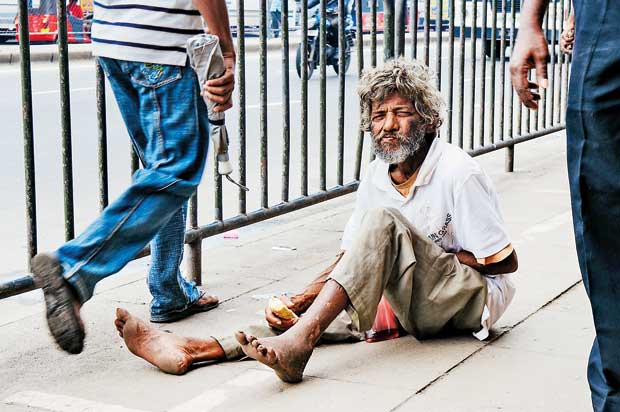Panhandling or begging is an act by a person who makes it a practice of imploring others to part with a donation, especially money. This is very much prevalent in societies the world over by adopting various ways and means. Usually it is done with a humble request vocally with sympathetic appeals.Coercing money by demand takes place on Sri Lankan roads by beggars boldly tapping on car shutters when vehicles come to a stop at traffic lights, which is most intimidatory.
Begging at traffic lights

Aggressive panhandling involves soliciting donations in an intrusive manner, especially from foreign tourists in Sri Lanka, where beggars are seen following foreigners in ‘Pied Piper’ fashion, and not taking ‘no’ for an answer. In certain cases, supplicating can be in a loud voice, often accompanied with wild gesticulations and use of insults, curse or veiled threats.
Aggressive begging with wild gesticulations

Poverty and destituteness are two different issues altogether, as long as it is credible, but should those with compassionate hearts become suckers to tricksters at all, who seem to take one’s sincerity as a weakness?
Different Tactics
Various types of panhandling take place when some beggars bring with them young children or pet dogs to draw attention of the public sympathy. Some adopt a different ploy of playing a musical instrument. In short, currently, begging has become a habitual manipulation to draw compassion for monetary gains
Bringing Children for begging

Panhandlers choose particular spots that are exceptionally intimidating to solicit, such as near automated teller machines. Apart from the common type of street begging in public, more advanced and sophisticated methods adopted today include cyber-begging, which is done on the internet, seeking money to meet numerous needs and deeds.
This type of supplication has a clear advantage over face-to-face street panhandling, because of its ability to eliminate the shame due to incognito approach. Another form of foul play that takes place is by approaching rich individuals with prayerful letters, usually when lottery winners are exposed publicly. Charles Dickens in 1850 exposed samples of numerous begging letters he had personally received over the years, describing the variety of ploys adopted to seek funds.
Religious perspective
Catholic followers believe that Saint Francis of Assisi and Saint Dominic as mendicants, who begged for food, while they preached to the villagers. In traditional Christianity, rich are encouraged to serve the poor. In many Hindu traditions, seeking food is regarded as a materialistic distraction from the search for ‘Moksha’(spiritual liberation). Spiritual dimension on the other-hand makes one to believe that begging promotes humility and gratitude, not only towards those who give food, but towards the universe in general. Dervish members of Islam adopt ‘Zakat’(similar to a wealth tax), which is a compulsory charity for every Muslim during one’s life time. In monastic orders of Buddhism, monks seeking food during ‘Vassana’(rainy season) is referred to as ‘Pindapatha’. In general terms, all meritorious deeds of generosity tend naturally to fulfil another dimension of their self-advancement ‘to seek’ a better spiritual station after death.
International beggars
An interesting video released by ‘Facts Verse’, which has gone viral at present, gives a different dimension to panhandling – exposing ten international individuals, identified each one with photographs, as the top ten richest panhandlers in the world.
Number one.
Salmon Ryde, claimed as a Londoner, who is 37 years of age, who spends at least eight hours a day on the London streets, and on extra time with his dog. He wears ratty clothes and picks up a particular area of choice next to a NatWest cash point, close to a railway station each day, where thousands of commuters pass by and give him money. His earnings are estimated at £50,000 a year. Each night he goes back to his £300,000 flat in Fulham. Begging in West London really pays him well. In the UK it is illegal to beg, but it does not carry a jail sentence under the Vagrancy Act of 1824.
Number two.
One-hundred-year-old Asian woman, Eisha, was panhandling in Jeddah. She had been blind for years. She too had been on the streets in tattered clothing and begging from people. When people saw this blind old woman, holding a tin cup, people felt sorry for her, and they had no problem of donating money to a ‘homeless woman’!
When she passed away, she was found not to be that poor as she wanted people to think. Upon becoming ill, she had handed over her Last Will to a friend, with instructions not read it until she was dead. When she passed away and her last will was read, it had revealed that in her bank account she had Saudi Riyals 800,000 million and jewellary worth of US $200,000. Apart from her wealth, she owned four buildings in Jeddah. She had been helping homeless people she knew from the streets.
Number three.
Sambashi Kalle lives in Mumbai, who has no traditional job but panhandling. He and his family spend every day on the streets of Mumbai begging for money. He thinks begging could be very profitable. At the end of each day, his collection exceeds Indian Rs 1,000. They have Rs.40,000 in a savings bank account and with few thousands of rupees invested as fixed deposits in companies. Once he became tired of living in a Mumbai flat, he had bought two houses in Singapore.
Number four:
Krishna Kumar Gile is another beggar in Mumbai. His favourite spot for begging is near the CP tank in Tiny Road, Mumbai. He wears tatty clothes to look poor; however, he makes more money each day, more than the people who donate him money. His daily earnings exceed approximately Rs 1,500 daily out of panhandling, and he owns an apartment in Mava Supari in Mumbai.
Number five
Ervin Corey, 97, is a man from New York. For the last seventeen years he has been busy walking up and down the 35th Avenue always occupied in panhandling. He had been a comedy actor for years, and worked alongside Woody Allen and Jackie Greisen. He earns approximately US $100 to US $250 a day. What makes him stand out from other panhandlers is the fact that he donates his collection to a charity in Cuba, towards purchase of medical supplies for poor children in Cuba. He lives in a house worth US $3.5 million in East Manhattan. He also sells newspapers on the street and lives on with the money out of newspapers sales.
Number six
Laxmi Das came to the streets for begging when she was just 16 years of age. For the past 44 years she has been panhandling in Northern Kolkata. She spends very little money out of her panhandling earnings. At the age of 60, she has gone to the Bank with four buckets full of coins and deposited money worth £200.
Number seven
A pedestrian on a street has taken a photograph of an ‘unidentified man’who walks with his daughter. Both the father and daughter are seen in shabby clothes. The seated photograph of this ‘identified man’ shows how the father and daughter are seated on the pavement, and the little girl is covering her body with her father’s overcoat to keep her warm. However, a closer look at the girl’s pocket shows ignition keys of a Mercedes-Benz jutting out!
Number eight
Will Anderson, 43, is from New York. He spends his days with his 9-year-old dog ‘Resore’. His favourite spot for panhandling happens to be near the Grand Terminal at the 42nd Street, between Vanderbilt and Madison Avenue, New York, where he sits with his dog and a board displaying the words “spare any money for me and the pooch”. According to Anderson, his average daily collection is estimated at least US $200 per hour, which is a good income for a person who does nothing all day.
Number nine
Gary Thompson, originally from Texas, now lives in Kentucky. He uses a wheel chair to get around. Most of the people who donate money to him, out of sympathy, are not aware of the fact that he pretends to be physically and mentally handicapped. He makes US $100,000 each year out of panhandling on streets.
Number ten
Marshi, who is from India, hires an auto rickshaw every morning to travel towards his begging point. When he arrives at his permanent spot, he changes his clothes to scruffy garments and spends eight to ten hours a day begging for money. He is a multi-millionaire, who makes approximately Rs.15,000 a day. Those donors who donate him money out of sympathy do not have a clue that his income and his net worth is much higher than theirs! Marshi seems to think that panhandling requires long hours of patience and determination, but at the end of the day it is worth the trouble.
Today, Sri Lankan streets are inundated with panhandlers of many a sort, in every corner, be it a railway station, bus stand, or at traffic lights. At least the Sri Lankan Government has taken some stringent measures to stop panhandling inside buses and trains. Begging and prostitution have been in existence from time immemorial, and both are equally oriented towards spinning money.
All of these ultimately boils down to the fact that generosity is always exploited by individuals, who masquerade as beggars, which has turned into lucrative means of livelihood.

A scene from Colombo
Picture credit: google photos






